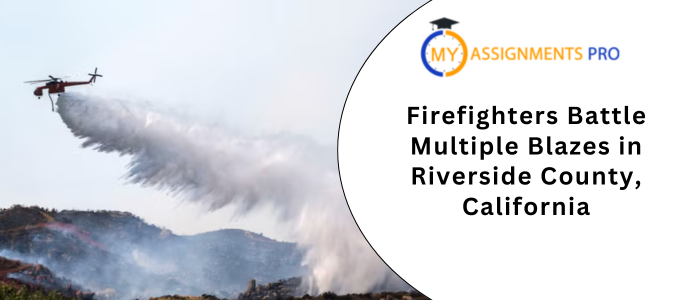
Emergency crews in California’s Riverside County, situated just east of Los Angeles, have been fighting to contain three separate wildfires that erupted earlier this week. Although evacuation orders have now been lifted for thousands of residents, firefighters are still hard at work attempting to bring the blazes under control.
Juniper Fire: The Most Concerning of the Three
The most significant fire, known as the Juniper fire, broke out late Monday morning around 11:30 a.m. local time. The blaze quickly tore through dry bushland, consuming nearly 700 acres within hours. This fire prompted immediate concern, leading Cal Fire—the state’s primary firefighting authority—to issue evacuation orders that affected more than 5,000 people in the region.
Although the evacuation order was lifted by 9 p.m. on Monday, the Juniper fire remained only 30 percent contained by early Tuesday. Firefighters have continued working overnight in difficult conditions to control the fire’s spread. According to Cal Fire, while the immediate danger has reduced, evacuation warnings remain in place, meaning residents should still be prepared to leave if conditions worsen.
The cause of the Juniper fire is currently under investigation, with authorities examining factors such as electrical faults, human activity, or natural ignition sources like lightning.
Two Other Fires Still Burning
The Juniper fire isn’t the only concern in Riverside County. A second blaze, called the Wolf fire, began on Sunday and has already charred over 2,400 acres of land. It too is only 30 percent contained, and crews are working under challenging weather conditions to limit further destruction.
A third blaze, the Mindy fire, also ignited on Sunday but has now been mostly contained. It burned through about 100 acres before being brought under control. All associated evacuation orders for that fire have now been lifted.
While no fatalities or injuries have been reported from these three incidents, the fast pace at which the fires spread is a reminder of how dangerous California’s fire season can be.
Australia’s Familiarity with Bushfire Devastation
For Australians, stories like this hit close to home. Many will recall the Black Summer of 2019–20, when bushfires ravaged parts of New South Wales, Victoria, and South Australia, killing 33 people and burning more than 24 million hectares of land. Though the fires in California are on a smaller scale, the patterns of heat, drought, and strong winds are familiar warning signs to Australians who have lived through similar disasters.
California and Australia share similar climates and fire-prone ecosystems, making both regions susceptible to intense wildfire activity—especially during the hotter months.
Conditions Ripe for More Fires
Experts warn that this year could be a particularly bad one for wildfires across California. Winter in Southern California was especially dry, failing to deliver the rain and snow needed to moisten the landscape. This means that grass, shrubs, and trees are more flammable than usual, increasing the risk of major fire outbreaks as the summer heats up.
According to fire authorities, September is likely to see heightened fire activity, particularly in southern and central parts of the state. Historically, California sees about 1.4 million acres burn each year. However, this number fluctuates dramatically depending on weather conditions and ignition sources.
For instance, 2020 was one of the worst years on record, with over 4.3 million acres burned due to a series of dry lightning strikes in Northern California. In contrast, 2022 and 2023 were comparatively mild, with around 300,000 acres burned each year.
Recent Wildfires Still Fresh in Public Memory
The Juniper fire comes just months after Los Angeles County residents endured devastating wildfires in January. The Eaton fire ravaged the suburb of Altadena, destroying over 9,400 structures and burning more than 14,000 acres. At the same time, the Palisades fire tore through Malibu and the Pacific Palisades, damaging 6,800 buildings and consuming 23,000 acres of land.
Tragically, these two events claimed the lives of 30 people, making it California’s second-deadliest fire event in history. Only the Camp fire in 2018 was worse, which resulted in 85 deaths and the near-total destruction of the town of Paradise in Northern California.
A Global Challenge: Adapting to More Frequent Fires
As climate change continues to alter global weather patterns, regions like California and Australia must confront a new normal where fire seasons are longer, more intense, and more unpredictable. Both countries are investing in new strategies to manage fire risk, from controlled burns and hazard reduction techniques to improved early warning systems and satellite monitoring.
In California, agencies like Cal Fire coordinate with federal and local partners to deploy thousands of firefighters, aircraft, and support vehicles during fire emergencies. Australia follows a similar model, with the Rural Fire Service (RFS) and Country Fire Authority (CFA) providing frontline support, especially in regional communities.
But even with all this preparation, the challenge remains: how to balance growing populations, urban development in bushland areas, and the undeniable threat posed by a warming planet.
What Lies Ahead
As California braces for a long and dangerous summer, firefighting efforts remain focused on immediate containment of active blazes like the Juniper and Wolf fires. The community, too, is playing a crucial role—following evacuation orders, preparing emergency kits, and staying informed.
For Australians watching from afar, these events serve as both a warning and a call to action. Whether in the bushlands of Victoria or the dry hills of Riverside County, fires don’t respect borders, and climate-related disasters are now an international concern.
Final Thoughts
The situation in Riverside County may seem like a world away, but it reflects a broader pattern of intensifying natural disasters that Australians know all too well. As authorities in California continue their battle against the flames, it’s a timely reminder for us here in Australia to remain vigilant, especially with our own fire season just a few months away.
Meta Title: Firefighters Battle Three Wildfires in California as Danger Grows
Meta Description: Firefighters in California are battling three major blazes in Riverside County. With over 3,000 acres burned and evacuations in place, experts warn this could be a severe fire season. Here's how Australians can relate.
Affordable and Trusted Assignment Help for Your Academic Journey
Struggling to manage tight deadlines or complex coursework? My Assignments Pro offers reliable and affordable assignment help designed to ease your academic stress. Our team of expert writers delivers 100% original, high-quality work that aligns with strict university guidelines. Whether you're studying business, law, nursing, finance, or any other field, our professional assignment help covers a wide range of disciplines. Benefit from on-time delivery, personalised academic support, and exclusive discounts on multiple assignment bookings. From essays and research papers to technical reports and final-year projects, our comprehensive assignment help services are dedicated to helping you achieve academic success every step of the way.Source
Mitchell
Mitchell is a seasoned Ph.D. scholar with extensive expertise gained through years of rigorous research, publication, and teaching experience. He brings a wealth of knowledge and analytical skills to tackle complex academic challenges. His work is dedicated to delivering innovative solutions, advancing knowledge, and promoting academic excellence. Proficient in research methodology, data analysis, and scholarly writing, Mitchell has contributed to peer-reviewed journals and mentored students to achieve academic success.


